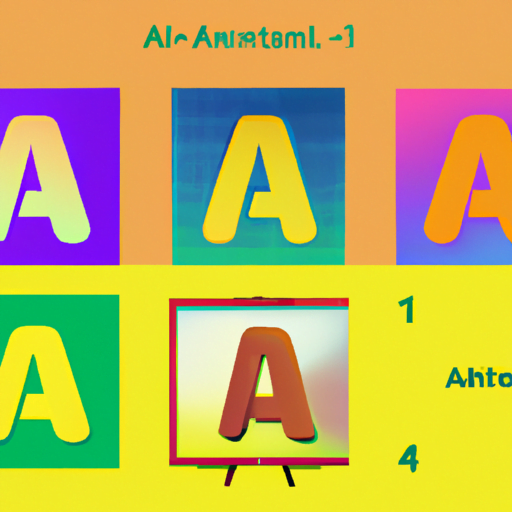
-
Table of Contents
AI in Typeface Design: Custom Fonts for Unique Branding

Typography plays a crucial role in branding and design. The right typeface can evoke emotions, convey a brand’s personality, and create a memorable visual identity. In recent years, artificial intelligence (AI) has revolutionized the field of typeface design, enabling designers to create custom fonts that are unique, scalable, and tailored to a brand’s specific needs. This article explores the impact of AI on typeface design and how it is reshaping the way brands approach their visual identity.
The Evolution of Typeface Design
Typography has come a long way since the invention of movable type in the 15th century. From the early days of metal type to the digital revolution, typeface design has constantly evolved to meet the changing needs of communication and design. In the past, creating a custom font required extensive manual labor and expertise. Designers had to meticulously draw each letterform by hand, making the process time-consuming and expensive.
With the advent of digital tools, typeface design became more accessible, but it still required a deep understanding of design principles and technical skills. Designers used software like Adobe Illustrator or FontLab to create fonts, relying on their creativity and expertise to craft unique typefaces. However, this process was still limited by human capabilities and the time it took to manually design each character.
The Rise of AI in Typeface Design
Artificial intelligence has brought a new level of automation and efficiency to typeface design. By leveraging machine learning algorithms, AI can analyze vast amounts of data and generate custom fonts based on specific design parameters. This technology has opened up new possibilities for designers and brands, allowing them to create unique typefaces that were previously unimaginable.
One of the key advantages of AI in typeface design is its ability to generate fonts at scale. Instead of manually designing each character, designers can input a few key parameters, such as the desired style, weight, and proportions, and let the AI algorithm generate the entire font set. This not only saves time but also ensures consistency across different characters, resulting in a more cohesive and professional-looking typeface.
Case Studies: AI in Typeface Design
Several companies and designers have already embraced AI in typeface design, showcasing its potential in creating unique and impactful fonts. Let’s explore some notable case studies:
1. IBM Plex
IBM Plex is a typeface designed by Mike Abbink and the IBM Brand & Experience team. The team used AI to create a versatile and cohesive font family that reflects IBM’s brand values. By training the AI algorithm on a vast dataset of historical typefaces, the team was able to generate a font that combines modern aesthetics with a touch of nostalgia. The result is a typeface that feels both contemporary and timeless, perfectly aligning with IBM’s brand identity.
2. Google Fonts
Google Fonts, a library of open-source fonts, has also embraced AI in its typeface design process. By using machine learning algorithms, Google Fonts can analyze popular typeface trends and user preferences to generate new fonts that are both visually appealing and highly functional. This approach allows Google Fonts to continuously expand its library with fresh and relevant typefaces, catering to the diverse needs of designers and brands worldwide.
The Benefits of AI in Typeface Design
The integration of AI in typeface design offers numerous benefits for designers and brands:
- Efficiency: AI algorithms can generate custom fonts at a much faster pace than traditional manual methods, saving designers valuable time and resources.
- Consistency: AI ensures consistency across different characters, resulting in a more harmonious and professional-looking typeface.
- Scalability: AI enables designers to create fonts at scale, making it easier to adapt and expand a typeface for different use cases and platforms.
- Innovation: AI opens up new possibilities for experimentation and innovation in typeface design, allowing designers to push the boundaries of creativity.
- Personalization: AI algorithms can generate custom fonts based on specific design parameters, enabling brands to create typefaces that align with their unique visual identity.
The Future of AI in Typeface Design
As AI continues to advance, we can expect even more exciting developments in typeface design. Here are some potential future trends:
- Generative Adversarial Networks (GANs): GANs, a type of AI algorithm, could be used to create typefaces that combine the best elements of multiple existing fonts, resulting in truly unique and innovative designs.
- Emotion-driven Typography: AI could be used to analyze and interpret emotions, allowing designers to create typefaces that evoke specific feelings or moods.
- Dynamic and Responsive Fonts: AI algorithms could enable the creation of fonts that adapt and respond to different contexts, such as screen size, user preferences, or even real-time data.
Conclusion
AI has revolutionized the field of typeface design, empowering designers and brands to create custom fonts that are unique, scalable, and tailored to their specific needs. By leveraging machine learning algorithms, AI can generate fonts at scale, ensuring consistency and efficiency. Case studies like IBM Plex and Google Fonts demonstrate the potential of AI in creating impactful and memorable typefaces. As AI continues to advance, we can expect even more exciting developments in typeface design, pushing the boundaries of creativity and personalization.
